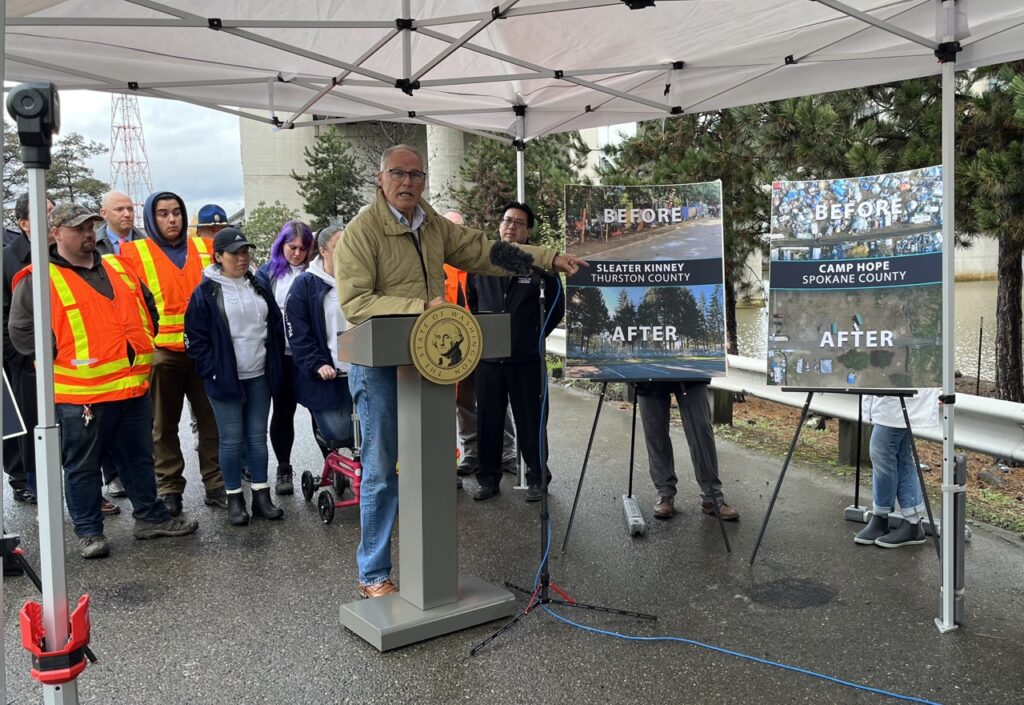Governor Jay Inslee has emphasized the accomplishments of Washington’s homeless encampment initiative, focusing on strategies to clear encampments and facilitate transitions for individuals into stable housing. Last December, he unveiled the state’s budget proposals regarding housing and homelessness at a former encampment site in Seattle, underscoring the urgency of the situation. The state Department of Transportation (DOT) has implemented a right-of-way safety initiative to address homelessness along highway corridors. Over the past two years, this initiative has successfully dismantled 47 encampment sites across five counties, significantly contributing to efforts aimed at reducing homelessness on state property. With 1,208 individuals who had previously resided in encampments having accepted housing, and 891 of those individuals currently housed, the program has demonstrated tangible outcomes.
Despite the successes, the DOT warns that continued efforts to maintain this progress will require additional funding. The legislative budget allocated $143 million at the program’s inception, yet faced with increasing costs and limited funds, officials state that only $5.5 million is available for the project through 2027. In previous budget sessions, Governor Inslee requested $10 million to sustain the initiative, but lawmakers only allocated $2 million. Consequently, Inslee pointed out the necessity for future legislators to address ongoing funding shortfalls to ensure the program’s continuity and expansion. The DOT has indicated that unless more resources are secured, the benefits already achieved may be compromised, emphasizing the need to maintain the momentum and support for this critical work.
The current initiative has remained predominantly within the state’s most populous counties—King, Pierce, Snohomish, Thurston, and Spokane—while the state has 100,000 acres of vegetated rights of way, indicating potential for expansion. Officials from the DOT, including Kris Abrudan, expressed the desire to broaden the program’s reach to additional counties, contingent upon legislative approval and the priorities of future administrations. Advocates like Carl Schroeder from the Association of Washington Cities hope that the model for resolving encampments can also be adopted at the city level, thereby enabling municipalities to address local homelessness effectively using similar strategies.
Yet clearing encampments is an arduous task that goes beyond mere displacement; it requires consistent and diligent monitoring to prevent re-establishment of encampments. Abrudan has pointed out that maintaining clear areas necessitates a workforce dedicated to on-site assessments carried out by department personnel or state patrol, which can significantly strain budgets. Additionally, the state has made investments in purchasing hotels and facilities for temporary housing solutions, but ongoing maintenance costs are often overlooked. As Schroeder highlighted, initial funding is only part of the equation; ongoing investment is crucial to ensure that facilities remain functional, and that service providers can sustain long-term support for the housed individuals.
Nonetheless, the overarching issue of housing shortages continues to pose significant barriers to the success of the program. Abrudan noted that current housing availability is inadequate to address the needs of substantial encampments, limiting the successful transition of individuals into stable living situations. The shortfall of available housing exacerbates the complexities faced by the encampment clearing efforts, revealing a systemic problem within Washington’s broader housing policy framework. As the initiative continues to evolve, it is paramount that strategies for creating and maintaining affordable housing are prioritized alongside encampment resolution tactics.
Ultimately, the long-term success of the homeless encampment initiative is contingent upon collaborative action at legislative, local, and state levels. While the recent achievements in clearing encampments and transitioning individuals into housing are commendable, they are only a small facet of a much larger puzzle. As challenges persist, particularly in securing ongoing funding and addressing housing shortages, there remains a vital need for comprehensive solutions that prioritize both immediate relief for those experiencing homelessness and sustainable measures that ensure housing security for all Washington residents. The commitment from both the current administration and incoming governance will be crucial for achieving these goals and firmly establishing a pathway out of homelessness for vulnerable populations across the state.

